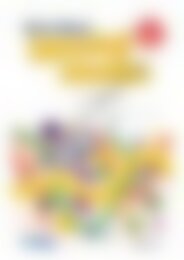RIC-3531 Primary Science - Book D (Digital)
You also want an ePaper? Increase the reach of your titles
YUMPU automatically turns print PDFs into web optimized ePapers that Google loves.
Bridge Building – 2<br />
Structures – Activity 4<br />
Lesson Focus<br />
Outcomes<br />
Natural and Processed<br />
Materials<br />
2.11 Observes and describes<br />
the characteristics of<br />
common materials.<br />
Indicators<br />
• Uses acquired knowledge<br />
to build bridges using<br />
new materials.<br />
• Investigates the role of<br />
compression and tension<br />
in deciding whether<br />
structures stay up or fall<br />
down.<br />
Skills Focus<br />
• Designs and constructs<br />
• Communicates<br />
• Investigates<br />
• Infers<br />
Background Information<br />
There are a number of ways<br />
to make paper rigid. These<br />
include rolling, folding,<br />
corrugating (like a concertina),<br />
angling and by creating<br />
shapes.<br />
Before the Lesson<br />
Materials Needed<br />
Paper, tape<br />
Preparation<br />
Ensure a sufficient supply of paper. Anything from newspaper to photocopy paper<br />
is suitable, but the paper supplied to the class should all be the same. Organise the<br />
class into small groups.<br />
The Lesson<br />
Stimulus<br />
• Using a single sheet of paper, illustrate the paper’s lack of rigidity by waving it in<br />
the air and trying to get it to stand up vertically, unsupported.<br />
• Discuss with students what can be done with the paper to make it more rigid.<br />
• It is important that students be provided a ‘free-play’ time to get rid of excess<br />
excitement related to the new materials. Students could be asked to make as many<br />
different shapes as they can. Discuss results.<br />
What to Do<br />
• Ask the students to build a bridge similar to Lesson 3 using only tape and paper. To<br />
complete this activity successfully, students will have to explore different ways of<br />
manipulating paper to convert it into rigid shapes.<br />
These include:<br />
(i) rolling<br />
(ii) folding<br />
(iii) corrugating<br />
(iv) angling<br />
(v) creating shapes<br />
This activity is more challenging than using straws and groups should be<br />
encouraged to use their acquired knowledge from previous lessons and to<br />
experiment.<br />
• Have students, in groups, experiment with pieces of paper, trying to make them<br />
more rigid.<br />
• Ask the students to apply knowledge from the previous lessons and the first<br />
activity to build a bridge over a 50-cm gap. Discuss rules as in Lesson Three,<br />
especially focus on the overuse of tape. This can be controlled by supplying a<br />
limited amount of tape to each group.<br />
• As a class, decide on a set of rules that each group must abide by while making the<br />
paper bridge. Display the rules on the board.<br />
• The students build their bridges.<br />
• The students complete the activity sheet, identifying the strengths and weaknesses<br />
of their bridges.<br />
After the Lesson<br />
Answers<br />
Answers will vary.<br />
Additional Activities<br />
• Explore tower and bridge building with different materials.<br />
• Survey bridges in the local community. What method(s) are used to provide<br />
strength and rigidity?<br />
• Investigate the different types of bridges (cantilever, arch, beam, truss, suspension<br />
etc.).<br />
Display Ideas<br />
Display the students’ paper bridges. The students can use a word processor to<br />
type a recount of their investigation. The text can be placed on coloured card and<br />
attached to the wall or folded so that it will stand up next to their creation.<br />
58 PRIMARY SCIENCE ~ R.I.C. Publications ® ~ www.ricpublications.com.au<br />
ISBN 978-1-925660-54-8<br />
©R.I.C. Publications<br />
Low Resolution Images<br />
Display Copy

















